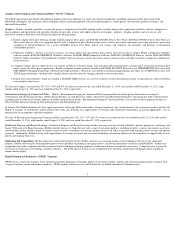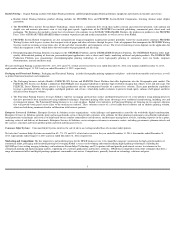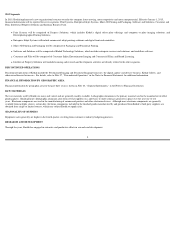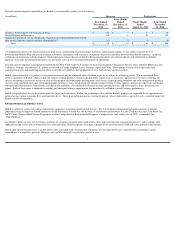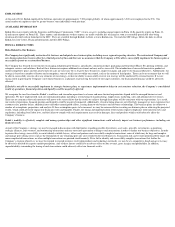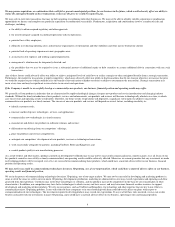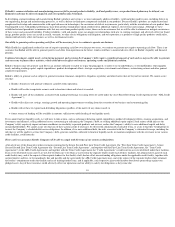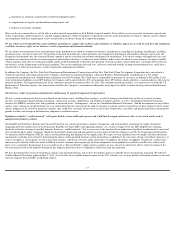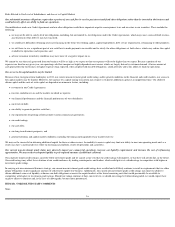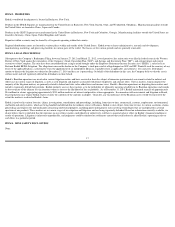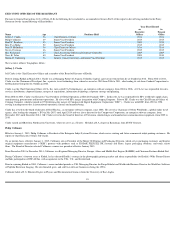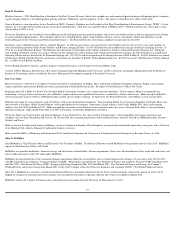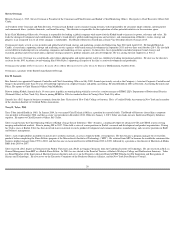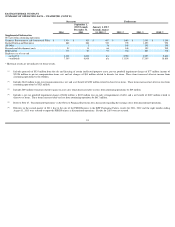Kodak 2014 Annual Report Download - page 15
Download and view the complete annual report
Please find page 15 of the 2014 Kodak annual report below. You can navigate through the pages in the report by either clicking on the pages listed below, or by using the keyword search tool below to find specific information within the annual report.
Kodak
’s future pension and other postretirement benefit plan costs and required level of contributions could be unfavorably impacted by changes in actuarial
assumptions, market performance of plan assets and obligations imposed by legislation or pension authorities which could adversely affect our financial position, results
of operations, and cash flow.
Kodak has significant defined benefit pension and other postretirement benefit obligations. The funded status of our U.S. and non U.S. defined benefit pension plans (and other
postretirement benefit plans), and the related cost reflected in our financial statements, are affected by various factors that are subject to an inherent degree of uncertainty. Key
assumptions used to value these benefit obligations, funded status and expense recognition include the discount rate for future payment obligations, the long term expected rate
of return on plan assets, salary growth, healthcare cost trend rates, mortality trends, and other economic and demographic factors. Significant differences in actual experience,
or significant changes in future assumptions or obligations imposed by legislation or pension authorities could lead to a potential future need to contribute cash or assets to
Kodak’s plans in excess of currently estimated contributions and benefit payments and could have an adverse effect on Kodak’s consolidated results of operations, financial
position or liquidity.
In past years, we have experienced increases in the costs of these defined benefit pension and postretirement benefit obligations as a result of macro-economic factors beyond
our control, including increases in health care costs, declines in investment returns on pension plan assets and changes in discount rates and mortality rates used to calculate
pension and related liabilities. At least some of these macro-economic factors may again put pressure on the cost of providing pension and medical benefits. There can be no
assurance that we will succeed in limiting cost increases, and continued upward pressure, including any as a result of new legislation, could reduce the profitability of our
businesses.
Kodak
’s businesses experience seasonality of sales. Therefore, lower demand for Kodak’
s products or increases in costs during periods that are expected to be at peak in
seasonality may have a pronounced negative effect on our results of operations.
Equipment and consumables sales generally exhibit higher levels in the fourth quarter due to the seasonal nature of placements, resulting from customer or industry budgeting
practices. As a result, a sequential quarter-to-quarter comparison is not a good indication of our performance or how we will perform in the future. In addition, adverse
developments during what are expected to be peak periods in seasonality, such as lower-than-anticipated demand for Kodak’s products, an internal systems failure, increases
in materials costs, or failure of or performance problems with one of our key logistics, components supply, or manufacturing partners, could have a material adverse impact on
our financial condition and operating results. Tight credit markets that limit capital investments or a weak economy that decreases print demand could negatively impact
equipment or consumable sales. These external developments are often unpredictable and may have an adverse impact on our business and results of operations.
If we fail to manage distribution of Kodak
’s products and services properly, our revenue, gross margins and earnings could be adversely impacted.
We use a variety of different distribution methods to sell and deliver Kodak’
s products and services, including third party resellers and distributors and direct and indirect sales
to both enterprise accounts and customers. Successfully managing the interaction of direct and indirect channels to various potential customer segments for our products and
services is a complex process. Moreover, since each distribution method has distinct risks and costs, Kodak’s failure to achieve the most advantageous balance in the delivery
model for our products and services could adversely affect our revenue, gross margins and earnings. This has concentrated Kodak’
s credit and operational risk and could result
in an adverse impact on our financial performance.
Kodak
’s future results could be harmed if we are unsuccessful in our efforts to expand sales in emerging markets.
Because we are seeking to expand our sales and number of customer relationships outside the United States, and specifically in emerging markets in Asia, Latin America and
Eastern Europe, Kodak’s business is subject to risks associated with doing business internationally, such as:
•
support of multiple languages;
•
recruitment of sales and technical support personnel with the skills to design, manufacture, sell and supply products;
•
compliance with governmental regulation of imports and exports, including obtaining required import or export approval for our products;
•
complexity of managing international operations;
•
exposure to foreign currency exchange rate fluctuations;
•
commercial laws and business practices that may favor local competition;
•
multiple, potentially conflicting, and changing governmental laws, regulations and practices, including differing export, import, tax, anti
-
corruption, anti
-
dumping,
economic sanction, labor, and employment laws;
•
difficulties in collecting accounts receivable;
•
limitations or restrictions on the repatriation of cash;
14


